Abstract
Tourism is one of the largest and major industries in the world. The sector has become a major source of income for numerous economies. Its significance is growing by the day. China, as the most populous country in the world, is projected to become a major market for both inbound and outbound tourists.
Consequently, Chinese authorities in the various provinces are promoting tourism in their regimes to attract both local and foreign visitors. Recently, the number of European tourists travelling to China has increased. The proposed study is an exploration of Shanghai to create a tourism experience for the European traveller.
Various factors leading to this experience are analysed in the study. In addition, the factors that can facilitate more European tourists visiting Shanghai are explored.
Introduction
Background Information
One of the major industries in the world today, and which is exhibiting considerable growth in importance, is that of tourism. The industry is a substantial source of income and employment in numerous economies worldwide. In addition, it is of social importance to many people. China currently boasts of the world’s largest population.
It is predicted that the country is going to become a major source of global tourists in the 21st century. On the other hand, the country is also becoming a major tourist attraction. China’s opening up to the world in the last few decades has greatly enhanced its image as a popular tourist destination.
Various Chinese cities are competing to become number one foreign tourist destinations. To this end, these cities are coming up with measures to woo more tourists. Some of these popular destinations include Shanghai, Guangzhou, Beijing, and Chengdu.
In the recent past, diplomatic relations between the European states (EU) and China have improved. For instance, more than 50 dialogues are currently taking place between the two sides through annual summits (Pantucci 2012).
The dialogues focus on three major pillars. The three are economic and sectoral, strategic, and people-to-people relations between the two economies (Pantucci 2012). Tourism between the two regions falls under the people-to-people diplomatic concerns. China is undertaking considerable measures to make its cities major tourist destinations for the Europeans.
Shanghai, as one of the large metropolitans in China, is a very popular tourist destination for both locals and foreigners. The various sites of attraction in the city create a unique tourism experience, giving the metropolis a major ranking globally. The authorities are putting in place measures to woo large numbers of tourists from Europe.
Problem Statement
According to Bayes (2004), Shanghai is a Chinese city with an allure of its own. It is characterised by a combination of western and local cultures. The city is sophisticated and cultured. In addition, it is emerging as a major economic powerhouse in China. Western visitors are usually amazed by its air of mystery.
Some recent developments, however, threaten to jeopardise the standing of this region on the global tourist market. For example, in the recent past, China had not been very open to the world, and especially to the western countries.
According to Lew and Yu (1995), before the 1970’s economic reforms, the country shunned external relations with other countries. Instead, the country focused on domestic industries, suppressing major economic relations with foreigners, including tourism engagements.
The post 1978 economic reforms in China led to an open door policy, which has been a significant driver to the rapid development in the country. For instance, China has made considerable progress in foreign investments. The country has invested in more than 5973 enterprises outside its territories, with tourism being one of them (Lew 2001; Zhang 1995).
Prior to the reforms, the country had very restrictive policies determining who entered as a tourist (Gareth & Allan 2002). Until recently, language barriers made China an unpopular destination with European tourists. According to Hall and Page (2000), negative depictions of the country in the western media have also been an obstacle in wooing foreign tourists.
It is a fact that some of the stories carried in foreign media outlets about this country may be right. However, some of these outlets ignore the positive aspects of the region, which reveal the attractiveness of the country to tourists from Europe.
Several issues in relation to environment, pandemics, climate change, human rights, natural resources, as well as energy supplies and demand have been used to discredit China. Such coverage can and should be considered as selective. The coverage depicts China as a dangerous place, posing major threats to global environment (Tan 1986).
However, since the adoption of the reforms and the open policy, China has become a major destination for global tourists, and especially Shanghai. The World Tourism Organisation (WTO) predicted that by 2020, the country would be the largest tourist destination in the world (Pantucci 2012). In addition, the country would also be among the largest in relation to overseas travel.
The proposed study will explore Shanghai in order to create a tourism experience for the European travellers. The study will highlight the factors that are set to increase the number of European tourists visiting Shanghai-China. Creation of such experiences would dispel the popular notion discouraging some European tourists from visiting China.
Significance of the Research
Tourism is currently recognised as the world’s largest and fastest growing industry (Cooper & Wahab 2001). Although China is an emerging economy and EU a relatively developed one, both stand to gain immensely from tourism. In addition, this sector is making meaningful contributions to the development of Shanghai and EU economies. The contributions are especially apparent in foreign exchange earnings and job creation.
Shanghai can further play a very significant role in wooing and convincing European tourists to come to China. Japan, Korea, USA, Taiwan, and Hong Kong are the leading sources of overseas tourists for Shanghai (World Expo 2010). The Expo further notes that tourists from Europe have increased over the years (World Expo 2010). Germany, France, and Britain were the leading origins of European tourists travelling to Shanghai.
The proposed study is relevant to European and Shanghai tourism industries. It is important for Shanghai to create a comprehensive tourism experience for the European traveller. Knowledge on the systems of operation for the Shanghai tourism industry will be made available to the European tourist.
Consequently, a new image of Shanghai as a choice destination will be enhanced. A popular perception of Shanghai as an exciting destination for leisure and business travellers can be enhanced through such an image.
It is apparent that convincing the European tourist to venture into Shanghai requires data and resources that can be used to enhance the city’s image. The information also needs to be updated regularly to make it more relevant.
Limitations and Delimitations of the Study
Shanghai is a very modern city considered to be a major gateway destination in its own right. In addition to its modern infrastructure, the city has maintained most of its traditional features. Visitors have the privilege of seeing and experiencing the culture and history of China, as well as that of the city itself.
The study will focus on the major attraction sites in Shanghai that can be used to create a lasting experience for any tourist. Shanghai is endowed with a number of such sites. The study will focus on the most popular ones.
In the proposed study, European tourists are considered as individuals travelling for leisure from the EU countries. For the last thirty years, the number of European tourists to China has grown immensely.
The signing of the Approved Destination Status (ADS) between China and the EU in 2004 further enhanced the prospect of more foreign tourists (Staiger 2004). Similarly, the agreement enhanced the prospects of more Chinese visiting the EU countries. The restriction of the current study on the EU countries is based on this fact.
Literature Review
Introduction
Chapter one addressed the background to the proposed study and developed the problem statement. The current chapter will review various studies regarding Shanghai as a destination for foreign tourists.
In addition, the chapter will highlight diplomatic relations between China and the EU. In addition, the major attraction sites for European tourists travelling to Shanghai will be analysed. Finally, the researcher will highlight the city’s destination management initiatives.
Shanghai-China
According to Bayes (2004), Shanghai is a city located on a coast. It acts as the gateway to the Yangtze River Delta, famous for its depiction of Chinese cultural and historical backgrounds. As a municipality, Shanghai is under the jurisdiction of China’s Central Government. It is also the largest trade and economic centre in the country. In addition, it has the largest port in China (World Expo 2010).
Bisected by River Huangpu, Shanghai faces the East China Sea, which is a part of the Pacific Ocean. The city is the most populous metropolis in the world. As of 2013, it had a population of more than 24 million persons. The city is also a major global financial centre.
Shanghai is known throughout the world due to its prosperous cosmopolitan features, which are complemented by its rich ‘humanistic’ resources (World Expo 2010). In the recent years, for instance, several modern buildings have been erected in the city.
Some of these include Shanghai Museum, Shanghai Grand Theatre, Shanghai Library, and the popular Oriental Pearl Television Tower (Shanghai Jiao Tong University [SJTU] 2014). Other popular buildings include Jin Mao Tower, Shanghai City-Planning Exhibition Hall, Shanghai Circus City, and the Shanghai Science and Technology Museum (SJTU 2014).
The buildings, together with other oriental architectural marvels, make up some of the most scenic sites in the city. In addition, colourful festivities, such as the Shanghai China International Art Festival and Shanghai Tourism Festival, are popular. All these elements act as significant tourist attractions for both locals and foreigners.
Development of Diplomatic Relations between China and EU Countries
Diplomatic relations between China and the EU began more than thirty years ago. According to Dai (2006), these relations began as early as May 1975. Subsequently, by the end of the 1970s, several events in relation to these relations took place. An example is the signing of an agreement between EU and China in Brussels.
Other events include visits to China by the then presidents of the European Community and European Parliament (Zhang 1995). The launch of China’s economic reforms and policies regarding opening up of the country in 1970s further strengthened the ties.
EU-China bilateral ties broadened in the 1980s, covering such aspects as academic and cultural exchange (Zhang 1995). Development of scientific programmes, as well as trade ties and cooperation, also deepened. The extent of these relations can be discerned from, for instance, the establishment of a Delegation of European Commission in Beijing. The delegation was established in 1988.
The relations between the two sides were, however, strained following the crackdown on students’ protests in 1989 by the government (Zhang 1995). The incident, which took place at the Tiananmen Square, prompted the European Community to freeze ties with China (Pantucci 2012). Such sanctions as arms embargo followed. The sanctions were inspired by similar actions taken by the US against China.
Freezing of the EU-China relations was however short lived. As the years progressed, the importance of China as a Foreign Direct Investment (FDI) became more apparent. Importance of China as a global competition frontier for the Triad Economies (Europe, US and Japan) also led to dropping of the sanctions.
Three years following the massacre at Tiananmen Square, relations between China and the EU were normalised. The sanctions by the EU were dropped, with the exception of the arms embargo (Dai 2006).
According to Zhang (1995), the EU-China relations have further deepened, since the 1990s. Several annual summits have been launched between the two sides, from 1998. In addition, high-profile visits between the two sides have further strengthened the relations. The two countries are finding that they are important to each other.
The mutual feeling of importance is evident in the foreign policies relating to each other by the two sides. For instance in 2004, the EU became the largest trading partner of China (Dai 2006). On its part, China conducts significant trade volumes with the EU. For example, it was the second trading country in that year.
It is thus evident that China and EU have very crucial and strong diplomatic ties, in the various social and economic aspects. Both sides benefit each other mutually. Consequently, Shanghai can seek to benefit from these relations, in furthering its tourism objectives with the EU.
Major Tourist Attractions in Shanghai-China
Perhaps the definition of a tourist attraction should precede creation of tourist experience in any destination of tourism. According to Wang and Pizam (2011), an attraction refers to any object, person, concept, or place that draws people so that they might have an experience.
An attraction can either draw people geographically, or through remote electronic means as witnessed in the contemporary society. Tourism experience on the other hand can be spiritual, recreational or otherwise (Laws 1995).
Shanghai as modern city has numerous attractions for leisure travellers from all walks of life. As an attraction for European tourists, various descriptions of the city make it a curiosity for leisure travellers. Bayes (2004) for instance describes the city as a mixture of both the Western and Chinese cultures. Such a description of the city enhances the perception of Shanghai as having an allure of its own.
Shanghai can be regarded in tourism terms as cultured, sophisticated, and among the leading economic powerhouses of China. It is thus apparent that the city is not only a choice for leisure, but also for business travellers.
Oriental Pearl Radio and Television Tower
One of the major tourist attractions in Shanghai is the Oriental Pearl Radio and Television Tower. According to Eleftherios (2003), the tower is designed in a manner that it has eleven spheres (pearls), and three massive columns. Six high speed elevators built into the columns raise visitors to the viewing platform above. Although there are queues at the elevators, the viewing platform affords visitors a panoramic view of the city.
The lighting of the building also presents an impressive scene. The light on the tower is alternated according to the weather pattern, controlled via a computer system (SJTU 2014). Although there are other taller buildings in the city, the tower remains a very significant tourist attraction in the city.
Figure 1: Oriental Pearl Radio and Television Tower
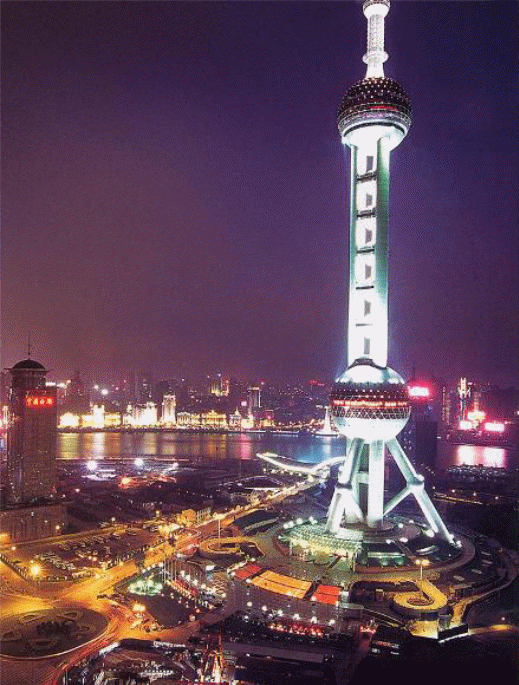
Source: SJTU (2014)
The Bund
The bund is the most famous landmark in Shanghai, regarded as a symbol of the new and the old (Eleftherios 2003). It is an imposing feature on the landscape of the country. It is four kilometres long. It stands out as one of the most important features in Shanghai. The landmark attracts both local and foreign tourists.
Earlier in the 1930s, the course of buildings constituting the bund hosted the city’s financial as well as commercial centres (Hall & Page 2000).
Numerous foreign banks and financial empires were hosted in the bund. Another feature is the Russian embassy in the city. It is an imposing blue structure near the bank of the river. In the colonial times both the British and the Japanese guards secured the bridge, which functioned as a boundary of territory (Zhang 1995).
The western wing of the Bund is equally striking. A number of buildings with varying architectural designs are found here. For instance, Gothic, Romanesque, and Baroque architecture buildings can be seen here. The combination of these architectural marvels results to a unique boulevard, a very beautiful site for tourists.
Figure 2: The Bund
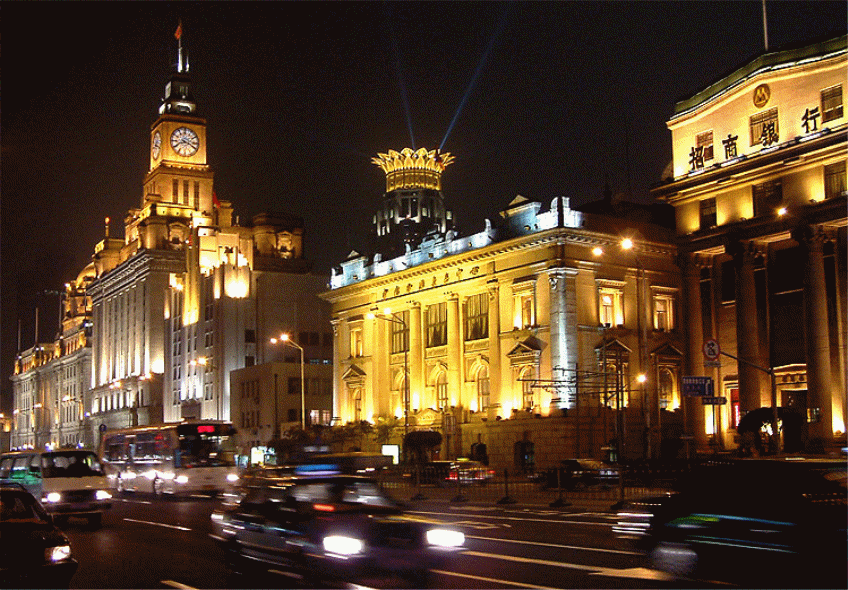
Source: SJTU (2014)
Jade Buddha Temple
Built during the era of the Guangxu of the Qing Dynasty (A.D. 1875-1909), the Jade Buddha Temple was burnt down during the early 20th century (Zhang 1995). It was restored in 1918. The Song Dynasty architectural designs influenced the new structure. The temple is made up of different areas. One of them is the Main Hall (Zhang 1995).
Today, the temple is occupied by a group of monks. In addition, the Shanghai Buddhist Instituted is housed in the shrine. A number of historical artefacts are also found in the temple. They include statues, religious scriptures, and paintings.
Figure 3: The Jade Buddha Temple
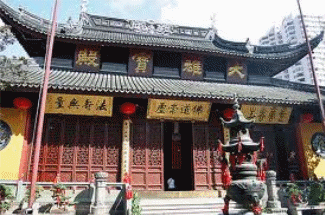
Source: SJTU (2014)
The People’s Square
It is another prominent feature in Shanghai. It is found at the centre of the city. The space occupied by the Square used to be a racing track before it was converted into a recreational feature for the larger public. The changes were carried out after the war, perhaps to cater for the rising demands for social amenities (Bayes 2004).
The People’s Square is significantly different from similar features in the country. For example, most public spaces are made up of concrete. However, the People’s Square is more natural. It is made up of plants, including trees and lush bushes. In addition, the square is surrounded by marvellous buildings. The People’s Square covers an area of 140 000 square meters (Zhang 1995).
At the northern end of the Square is the Municipal Government Mansion. The bureaucratic structure is, however, not accessible to members of the public. On the northwest lies the Shanghai Grand Theatre, constructed almost in entirety from glass. The Exhibition Hall for the City Planning is located on the East.
The Shanghai Museum however constitutes the most impressive building located in the square (SJTU 2014). The structure is symmetrical and has a very smooth texture. The design was inspired by a traditional cooking pot.
Figure 4: People’s Square
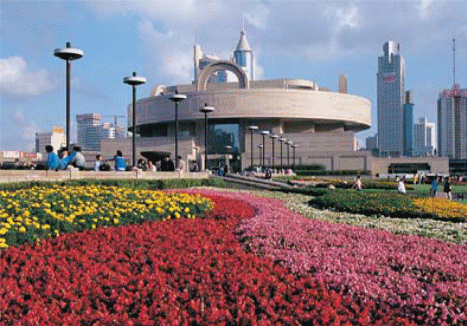
Source: SJTU (2014)
Yu Garden
Many tourists are attracted to this feature. It is located in the south-western part of the city. It is near the Bund. Yu Garden can be described as a Chinese Disney, only that it exhibits different twists, such as being lower in quality.
Yu Garden was first established by Pan Family in 1577, however it was destroyed twice in the 1800s (Zhang 1995). The Garden was however restored later. Although the garden usually has massive masses of people, visiting it while in Shanghai is worthwhile.
Yu Garden occupies a strategic place in the city. The surrounding area is made up of the Old City God’s Temple, referred to as the ‘Chinese City’ during the colonial times (Zhang 1995). The area surrounding the Garden has however been recently renovated, with numerous tourist attraction shops. The small side streets and the antique market are also very attractive sites for tourists.
Figure 5: Yu Garden
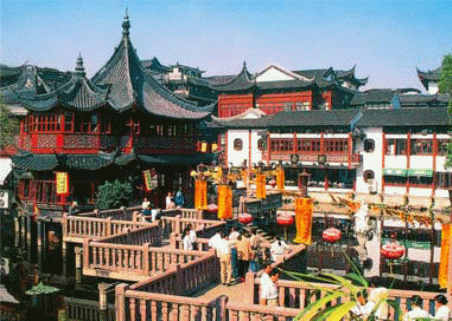
Source: SJTU (2014)
Xin Tian Di
Xin Tian Di Plaza is constituted of two blocks, the North and the South (Dai 2006). The southern part of the building is made up of modern architecture. The design is accompanied by Shikumen. Shikumen is a unique feature of Chinese architecture.
It is a combination of domestic and foreign cultures. The northern part of the building is equally captivating. It also has elements of Shikumen design. It is a beautiful contrast of the rest of the building. The South block hosts a shopping, leisure and entertainment complex, covering 25 000 square meters (SJTU 2014).
The South Block also has a series of international restaurants catering for the various world flavours. The same applies to the North Block. The restaurants specialise in American German, Italian, Brazilian, French, British, Japanese, and Taiwanese cuisine among others.
The combination displays the international dimension of Shanghai as a tourist destination, capable for catering for a variety of foreign tourists. The dividing line between the North and South Blocks of Xin Tian Di (which is the Xingye Road), is the site of the First Congress Hall of the Chinese Communist Party (Zhang 1995).
Figure 6: Xin Tian Di
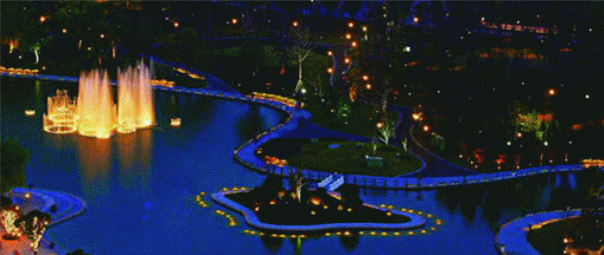
Source: SJTU (2014)
Destination Management in Shanghai-China
The magnificent attractions in Shanghai can be used to woo the European tourist by the spectacular experience that they create. However, another important aspect to creating the desired tourism experience can be further achieved through destination management. In this case, Shanghai would be the destination.
Mill and Morrison (2012) provide a working definition of destination management. Mill and Morrison (2012) regard it as the organisation of the various aspects of the destination mix. The elements constituting the mix should be in regard to a particular geographic area. In addition, these should be in relation to defined tourism plan or strategy.
Destination mix elements comprises of the attractions, events and facilities within the geographic location (Morrison 2012). Others include infrastructure and transport and communication network. Destination management also comprises of branding and marketing a given location. The marketing is targeted at both local and international travellers.
The various attraction sites, events, culture, among other aspects of Shanghai constitute the city’s destination mix elements. The destination mix of Shanghai develops the tourism experience that can attract more European tourists. The destination mix can also be regarded as the destination product, since the concepts are the same (Morrison 2012; Timothy 2001).
According to Knapp and Sherwin (2005), every destination mix must exhibit at least the four products namely physical, people, packages and programs. Physical products include items such as the attractions, transportation, facilities, and infrastructure (Mill & Morrison 2012). Tourists are drawn to the various attractions associated with a location, such as Shanghai.
It is apparent from the major attraction sites of Shanghai that the city has impressive physical products, which it can offer to the European tourist. The modern infrastructure of Shanghai and the transport system supports safe and enjoyable travelling in the city (SJTU 2014).
The hotel and restaurants in Shanghai meet the aspirations of the European traveller. The feature is another potential reason why the city is an emerging tourist destination.
It is important to take into consideration the people element of the destination mix. To this end, the local population accommodates and entertains the foreign tourists (Morrison 2012). Local lifestyles and cultures also constitute the people aspect of the marketing mix.
Shanghai city exhibits diverse cultures, from European, to Chinese. The various cultural events also indicate the awareness and appreciation of tourists by the city residents.
Different combinations of packages and programs are availed to the tourist. The European traveller can purchase and use these combinations. A number of tour operators have come up with unique packages for those travelling to Shanghai city (Morrison 2012).
Most of the packages are organised to attract different tourists. In addition, most of them are based on industry partnerships such travel and hospitality companies. The tourists can access the packages from conventional retail outlets. Such outlets include travel agents and online channels.
Destination mix programs are unique. They include the various events organised for the travellers (Harris, Griffin & Williams 2002; Mill & Morrison 2012). The European tourists can be further drawn towards Shanghai through well designed and promoted events and festivals.
Some European tourists have unique interests that should be addressed. The objective can be achieved through the use of prearranged packages. The city for instance hosts several colourful festivities such as the Shanghai China International Art Festival, and the Shanghai Tourism Festival (Lew & Yu 1995).
Shanghai has apparently made considerable effort in destination management, in order to become a global tourism choice, not only for the Europeans. For instance, the city has introduced a policy allowing visitors jetting into the country to stay for three days without a visa (Tourism Review 2013).
Travellers from more than 45 countries have already enjoyed the three day visa free stay in the ‘administrative area’ of Shanghai. In addition, the Shanghai Municipal Tourism Administration is seeking the Central Government permission to extend the same to the cruise terminals (Tourism Review 2013).
The aptness of Shanghai authorities in destination management is also apparent from the various expos held by the city such as the Shanghai 2010 world expo (Mill and Morrison 2012). Objectives of such events by the city included attracting visitors globally. The events also advance Chinese culture, in the world.
It is very easy to access many ports of China from Shanghai. Consequently, local organising committee sometimes organises trips for tourists within and outside the city (Tourism Review 2013).
For instance, these trips can be to the neighbouring water towns or historical cities such as Suzhou and Hangzhou. Arrangements to visit other popular tourist attraction in China can be made in Shanghai to other locations such as Hong Kong, Xian and Beijing. These cities are only two-hour flight away.
Conclusion
The diplomatic relations between China and the EU are apparently a stepping stone for Shanghai, in attracting more tourists from these countries. In addition, these relations have been developed for the mutual benefits of the two sides. In attracting tourists from the European countries, Shanghai offers a wide range of attractions that create a unique and lasting tourism experience. The destination management initiatives of Shanghai also make the city a choice destination for European tourists in Asia.
Research Methodology
Introduction
In chapter 2, a critical review of literature in this field was conducted. In this chapter, the design of the overall study is provided. The types of research methods employed in the study are described. In addition, the techniques employed in the study are also elaborated in this chapter.
Literature Review
Collection of materials in relation to exploration of Shanghai in order to create an experience focusing on the European tourist was a relatively difficult task. Most of the literature found focused on tourism in China as a whole.
In addition, materials focusing on specifically wooing the European tourists to Shanghai were even harder to come by. The literature review is majorly based on secondary materials that the author collected from libraries. In addition, online resources were extensively reviewed in order to develop a comprehensive image of Shanghai for the European tourist.
Data Collection Techniques
Generally, the bulk of this study is qualitative as opposed to quantitative. The title and objective of the study gives a certain orientation towards the methodology suitable for the study. Exploring Shanghai in order to create a tourism experience for the European Tourist is the overall objective of the study.
As indicated earlier, data collection is mostly based on materials collected from secondary sources in libraries and online databases. Travelling to the European countries to collect views on their perception of Shanghai as a tourist destination of choice could not be done.
Consequently, primary data was collected through questionnaires mailed to several European countries. Popular tourist agencies were requested to select some of their clients, who responded to the questionnaires. The trip would be apparently very costly to the author, hence the option on the method of data collection.
The author, however, made a point of touring most of Shanghai’s popular tourists’ attractions. The objective was to develop a firsthand experience, in order to enhance and compliment the information collected from the secondary sources.
Data Analysis
Despite of the study being qualitative, the responses from the questionnaires, as well as other secondary data need to be analysed. Consequently, the software SPSS version 10 would be used for the purpose of analysing and representing the data. SPSS refers to the Statistics Package for the Social Science.
SPSS is an integrated system comprising of computer programs, used in the analysis of social data (Norman, Dale & Hadlalh 1970). The system is designed in a manner that it provides social scientists with a comprehensive package. The package enables them various types of data analysis, in a very convenient and simple manner.
Limitations of the Study
Potential limitations to the study include:
- Since the research was limited to a tourism experience in Shanghai, the views represented do not necessary reflect destination China.
- Some of the respondents to the questionnaires might lack the specific aspect of the study which is focusing on Shanghai, and respond with a viewpoint of China as whole.
- The geographical area covered by the study is very large, hence become an impediment to collection of primary data in Shanghai and Europe directly by the author.
Conclusion
Shanghai offers a very fascinating, unique, and impressive destination for the European tourist. Traditionally, Europeans have shunned the idea of visiting this region, especially due to the distorted perceptions they had previously held about the country.
It is apparent that the diplomatic relations between China and Europe are improving. Shanghai can take advantage of these developments to lure more tourists to the region. The proposed study will determine some of the factors that can increase the number of European tourists to Shanghai.
References
Bayes, R. 2004, ‘An economic powerhouse’, Travel Trade, vol. 1 no. 2, p.21.
Cooper, C. & Wahab, S. 2001, Tourism in the age of globalisation, Routledge, London.
Dai, X. 2006, Understanding EU-China relations: an uncertain partnership in the making. Web.
Eleftherios, A. 2003, ‘Tourism in China: regional distribution and economic impact’, AEEADE, vol. 3 no. 2, pp. 45-60.
Gareth, S. & Allan, M. 2002, Critical issues in tourism a geographical perspective, Blackwell Publishers, Inc., London, UK.
Hall, C. & Page, S. 2000, Tourism in South and Southeast Asia: issues and cases, Butterworth Heinemann, Oxford.
Harris, R., Griffin, T. & Williams, P. 2002, Sustainable tourism: a global perspective, Elsevier Science Ltd., Burlington.
Knapp, D. & Sherwin, G. 2005, Destination BrandScience, Destination Marketing Association International, Washington, DC.
Laws, E. 1995, Tourist destination management: issues, analysis and policies, Routledge, London.
Lew, A. & Yu, L. 1995, Tourism in China: geographic, political and economic perspectives, Westview Press, New York.
Lew, A. 2001, “Tourism development in China: the dilemma of bureaucratic decentralisation and economic liberalisation”, in D Harrison (ed), Tourism and less development world: issues and case studies, CABI Publishing, Wallingford, UK, pp. 23-32.
Mill, R. & Morrison, M. 2012, The tourism system, Kendall/Hunt Publishing, Dubuque, Iowa.
Morrison, A. 2012, Marketing and managing tourism destinations, Routledge, London.
Norman, N., Dale, H. & Hadlalh, C. 1970, SPSS: Statistical Package for the Social Sciences, McGraw-Hill Book Company, New York.
Pantucci, R. 2012, Diplomatic links. Europe China research and advice network. Web.
Shanghai Jiao Tong University 2014, Shanghai at a glance. Web.
Staiger, B. 2004, Timeline of Chinese-European cultural relations. Web.
Tan, M. 1986, ‘China tourism: big growth, immediate problem’, China Reconstructs, vol. 35, no. 6, pp. 8-10.
Timothy, D. 2001, Tourism and political boundaries, Routledge, London.
Tourism Review 2013, Shanghai: visa-free stay luring tourists. Web.
Wang, Y. & Pizam, A. 2011, Destination Marketing and management: theories and applications, CABI, Wallingford.
World Expo 2010, Shanghai China communication & promotion plan. Web.
Zhang, G. 1995, “China’s tourism since 1978: Policies, experiences, and lessons learned”, in A Lew & L Yu (eds), Tourism in China: geographic, political and economic perspectives, Westview Press, New York, pp. 49-59.